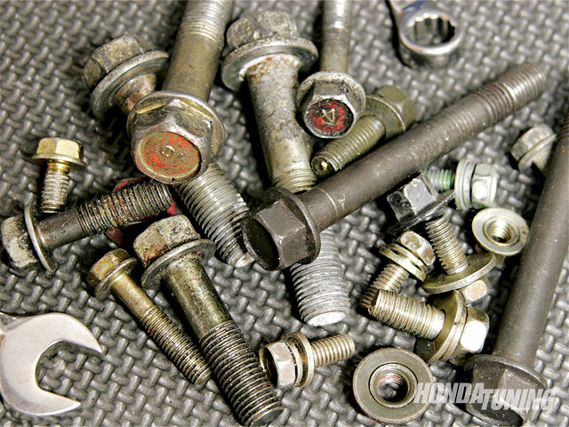 | Nuts & Bolts - Honda Tech Tips
| Nuts & Bolts - Honda Tech Tips
Embrace Your Inner Noob
You've got a damaged bolt-maybe it's stripped, maybe it's bent-so you head to the hardware store for a replacement. There you are, surrounded by bolts, nuts, washers, and all sorts of small hardware. But which one do you need? If you knew just a little bit about how bolt sizes are interpreted, then finding the right one would be a whole lot easier. Aside from the U.S., most countries use the metric system for classifying hardware, which means your Honda is assembled with metric hardware. You've just narrowed down your search to a single aisle. Most metric bolts you'll find in the hardware store are stamped with some sort of marking. For example, a metric bolt might have an "8.8" or a "10.9" stamped on its head while a standard U.S.-grade bolt might have three or five dashed lines on its face. If you don't see either, it's a low-grade bolt with a weaker tensile strength, meaning the amount of tension it can hold before it breaks is little. A bolt's tensile strength is also referred to as its "grade," and is something you should be very concerned with when replacing hardware on your Honda. Most Honda hardware is comparable to metric grade 10.9 or higher.
Steps To Knowing Your Bolts:
When determining bolt sizes, look to the numbers. Manufacturers use them for identification purposes. Metric ones will look something like this:
M3-0.4x10.
1. The "M" means that the bolt is metric while the "3" tells you that it has an outside diameter of 3 mm. The outside (also known as major) diameter is measured at the threaded portion of the bolt, not at the head where you put your wrench.
2. The second placeholder-"0.4" in this case-represents the distance between threads. Also known as the "thread pitch," it can be measured from peak to peak or from valley to valley; in this case it's 0.4 mm per thread, meaning there's a high spot and a low spot every 0.4 mm
3. The final number represents the length of the bolt, measured from the bottom of the head to the end of the bolt's threads. In the sample bolt's case it's 10 mm long.
More Tips:
If you come across an unknown bolt, a thread gauge can help you determine the thread pitch and size. If no such tool can be found, try screwing your bolt into a known mating thread, like an old nut that you have laying round. If you feel resistance, stop immediately to avoid stripping the threads.
One way to check if two bolts are the same is to set them side by side, facing opposite directions. If the threads mesh, they have the same thread pitch. This is also a quick way to check the length.
To measure the major diameter, you can find a wrench that fits snugly around the bolt's threads.
The majority of bolts are right-handed threads, meaning that they must be turned clockwise to tighten and counterclockwise to remove. Always remember, "righty-tighty" and "lefty-loosey."
